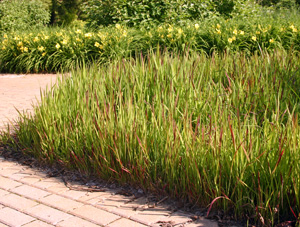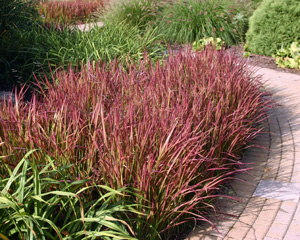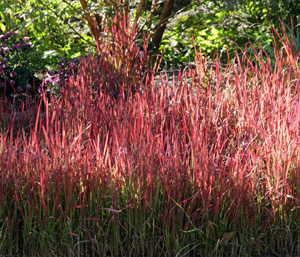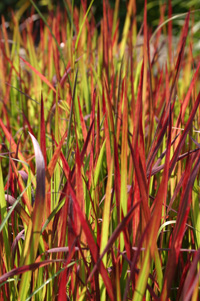
Imperata cylindrica is rhizomatous perennial grass native to east and southeast Asia, China and Japan. The species is an aggressive, green leaved plant also called cogon grass or kunai grass. It invades disturbed areas, such as roadsides, pastureland, and forest edges, to form dense monocultures and has been used for soil stabilization in some areas. In its native areas it has been used for thatching roofs of traditional buildings, weaving mats and bags, and making paper, as well as in traditional Chinese medicine. It has become naturalized in many tropical and subtropical regions areas outside its native range, including the southeastern U.S. as far north as Virginia, and is considered an invasive weed in many places. It was both accidentally and intentionally introduced to the U.S. in the early part of the last century, and despite prohibition on further planting, has continued to spread inadvertently on road construction or agricultural equipment or by other means. Because I. cylindrica is a listed Federal Noxious Weed, a federal permit is required to move it interstate.

A number of cultivars such as ‘Red Baron’ and ‘Rubra’ used as garden ornamentals are typically referred to as Japanese bloodgrass for the red color of the leaves. These are classified as Imperata cylindrica var. rubra or var. koenigii, and are short, cold-tolerant forms (normally listed to zone 5, but known to survive in zone 4b) with smaller rhizomes than the species. ‘Rubra’ has foliage tinged a burgundy color, while ‘Red Baron’ has brighter, cranberry-red coloration. The leaves are a bright green when they emerge in spring, then the red color develops on the tips and progresses down the leaf blade, becoming more intensely colored later in the season.

This red color may actually be a response to colder temperatures, as plants can revert to green when grown in a hot location. Reversions have substantially larger rhizomes than the red cultivars, so rubra varieties have the potential to become invasive. The red cultivated varieties were also thought to be sterile, but may not be. Even ornamental types are prohibited in most southern states but Japanese bloodgrass can still be grown legally in colder climates where the plants do not spread as rapidly and rarely flower. Imperata cylindrica is not listed as an invasive species in Wisconsin but even in northern areas it should only be planted in containers or in places where it cannot escape into natural areas.

The species is quite variable, growing 2-10 feet tall, although ornamental cultivars are only 12-18″ high. The narrow and sharply pointed vertical leaves have very finely serrated edges embedded with sharp silica crystals that can easily slice through unprotected skin; this feature makes this grass undesirable as a forage plant. The mid-vein of each leaf is lighter in color than the blade and is off center. The upper leaf surface is slightly hairy near the base of the plant but the rest is smooth. The leaves are light green when young but the color changes to brown or orange as they age. The ornamental cultivars have red tips on the leaves; the color becomes more vivid later in the season. Flowering is highly variable, and some clones never or only infrequently bloom. Panicles are filled with small seeds, each with a long, fluffy white plume that allows the seeds to disperse easily in the wind.

The leaves of Japanese bloodgrass are somewhat translucent, and create a spectacular appearance when backlit, so it is most effective in the landscape where it can be viewed with the early morning or late afternoon sun lighting up the leaves from behind, creating a red and green stained-glass effect. It fits well into rock gardens and borders, can be used as an edging plant, or massed as a ground cover. Combine it with fall-bloomers such as ‘Autumn Joy’ sedum or asters to focus attention on the grass when it is at its most intense color. It is also good in containers as long as they get plenty of water.
This is a warm season grass, and the leaves are killed by freezing temperatures. Winter mulching is recommended in zones 5 and 6 until well established. The plants remain dormant through the winter and are slow to emerge in spring.
This species tolerates a wide variety of soils – from wet to dry and from sand to clay – and prefers full sun but will grow in partial shade. The species can be propagated by both seed and rhizomes, but the ornamental types are only propagated by division.
– Susan Mahr, University of Wisconsin – Madison
Ask Your Gardening Question
If you’re unable to find the information you need, please submit your gardening question here:





 Aster, Symphyotrichum spp.
Aster, Symphyotrichum spp. Fascinating Fasciation
Fascinating Fasciation Alternatives to Lawn: Groundcovers
Alternatives to Lawn: Groundcovers Marigolds
Marigolds


